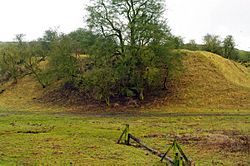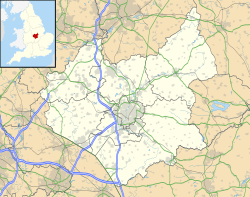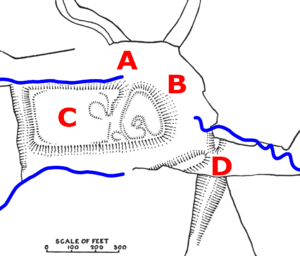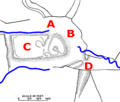Sauvey Castle facts for kids
Quick facts for kids Sauvey Castle |
|
|---|---|
| Withcote, Leicestershire | |

Surviving earthworks
|
|
| Coordinates | 52°38′20″N 0°50′13″W / 52.638977°N 0.837072°W |
| Site information | |
| Open to the public |
No |
Sauvey Castle is an old castle from the Middle Ages, located near Withcote in Leicestershire, England. It was likely built by King John in 1211. He probably used it as a quiet hunting lodge in Leighfield Forest.
The castle had a special design called a ringwork or shell keep, with a bailey next to it. To protect the castle, large earth dams were built. These dams flooded the area around the castle, making a big, shallow moat.
In the early years of King Henry III's rule, the castle was held by the Count of Aumale. After that, it stayed under the control of the Crown (the King). Royal foresters used it until the 1300s, when it was no longer needed. By the late 1600s, most of its walls and buildings were gone. Today, only the earthworks remain, and they are still in good condition.
Contents
Building Sauvey Castle
Historians are not completely sure when Sauvey Castle was built. Most believe King John built it in 1211. This was when he bought the land around it. However, some think it was built earlier, during the time of King Stephen, between 1135 and 1153.
The castle was hidden deep inside Leighfield Forest. If King John built it, he wanted it as a quiet place for hunting. Its name in Norman French was Salveé, which means "dark island."
Castle Design and Water Defenses
The castle sits on higher ground in a valley. Two small rivers, part of the River Chater, flow nearby. The main part of the castle is an oval area about 60 by 40 meters wide. This part is called a shell keep or a ringwork. A deep ditch separates it from a rectangular area called a bailey to the west. The bailey is about 100 by 70 meters in size.
The bailey had a guardhouse in its north-east corner. This guardhouse watched over the main entrance. Other buildings were built around the south side of the main oval area. There was also a chapel in the middle. The castle was mostly made of stone, with a strong wall around the main enclosure.
A wide ditch, between 20 and 60 meters across, was dug along the western side of the castle. A large earth bank, or dam, about 6 meters high, was built to the south-east. These structures allowed the area around the castle to be flooded. This created a big, shallow lake or moat for defense. You can see a similar moat design at Ravensworth Castle. There were also fishponds connected to the moat.
Sauvey Castle's History
The first records of Sauvey Castle are from around 1216. This was during the First Barons' War, a time of conflict. The government of the young King Henry III ordered the castle to be given to William de Fors, the Count of Aumale.
The Count of Aumale used the castle to build his power in the area. But in 1218, William Marshal, who was acting as regent (a temporary ruler) for the young king, told him to give it back. The count refused. More demands followed. Finally, in 1220, royal forces attacked and took the count's castle at nearby Rockingham Castle. To save face, the count then returned Sauvey Castle to the King. He said he did it willingly, and in return, the King canceled any debts the count owed.
Royal Use and Decline
During the 1200s, royal foresters used Sauvey Castle. These were people who looked after the King's forests. The castle also came with rights to the nearby land of Withcote. In the mid-1200s, the castle had a small "farm" fee. This was an annual payment of £3 owed to the King by whoever held the castle. In the 1240s, King Henry III ordered a timber chapel to be built at Sauvey Castle. Wood came from Rockingham Forest, and stones from a fallen stable were reused.
After 1246, the castle became less important. However, during the unstable times and revolts of 1258, King Henry III ordered Sauvey to be used as the sheriff's castle. This was for the counties of Leicestershire and Warwickshire, which did not have their own sheriff's castles. In 1289, the keeper of Rockingham Forest took stones and lead from Sauvey Castle. He reused them at Rockingham Castle.
The last time Sauvey Castle was mentioned as being actively used was in 1316. After this, it was probably left to fall apart. More stonework was taken by the keeper of Rockingham Forest in 1373. By this time, the castle was likely abandoned. By the 1400s, Sauvey was just a small part of the Withcote manor. This was the opposite of how it used to be. Most of its buildings were taken apart or destroyed by 1622. By the end of that century, they were completely gone.
Today, the site is protected under UK law as a Scheduled Ancient Monument. It is still in good condition. Historic England believes the castle's earthworks and moat design are very special. They say there are "few parallels nationally," meaning it's quite unique.
Images for kids





